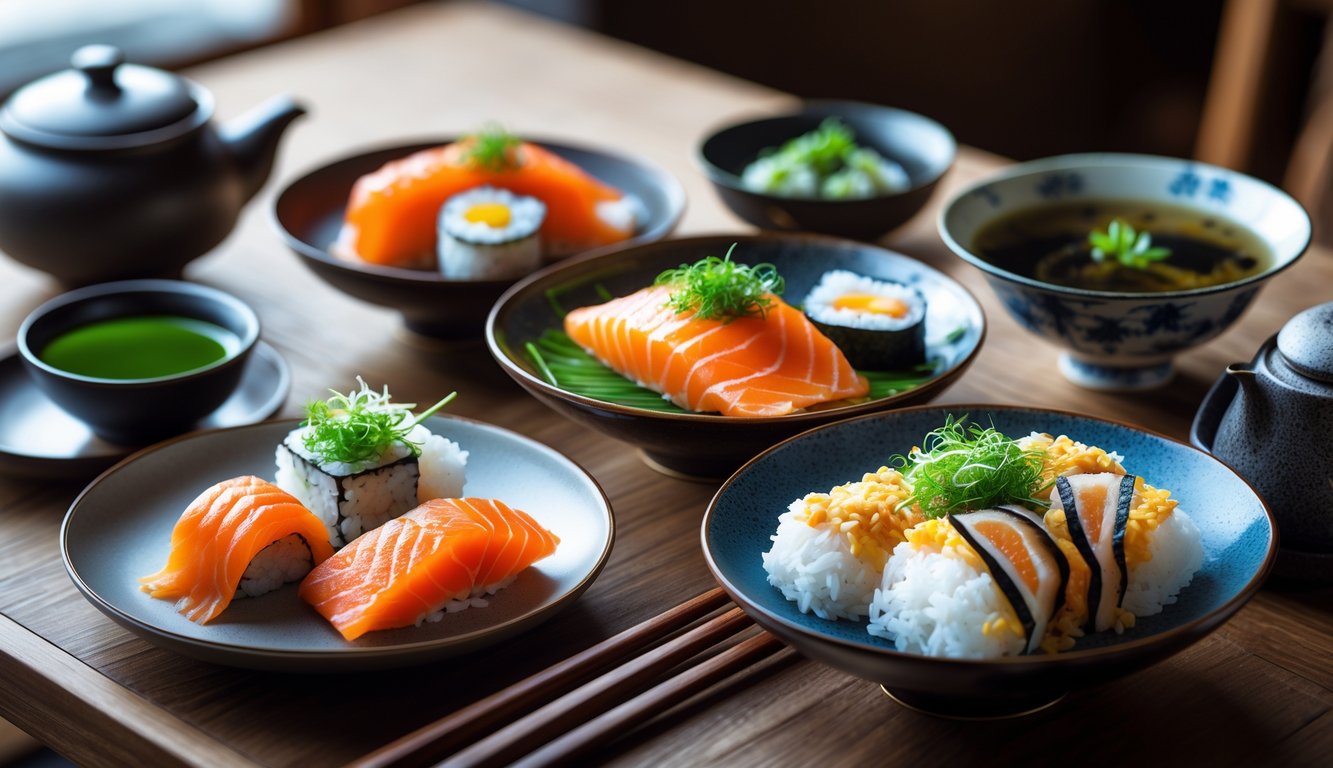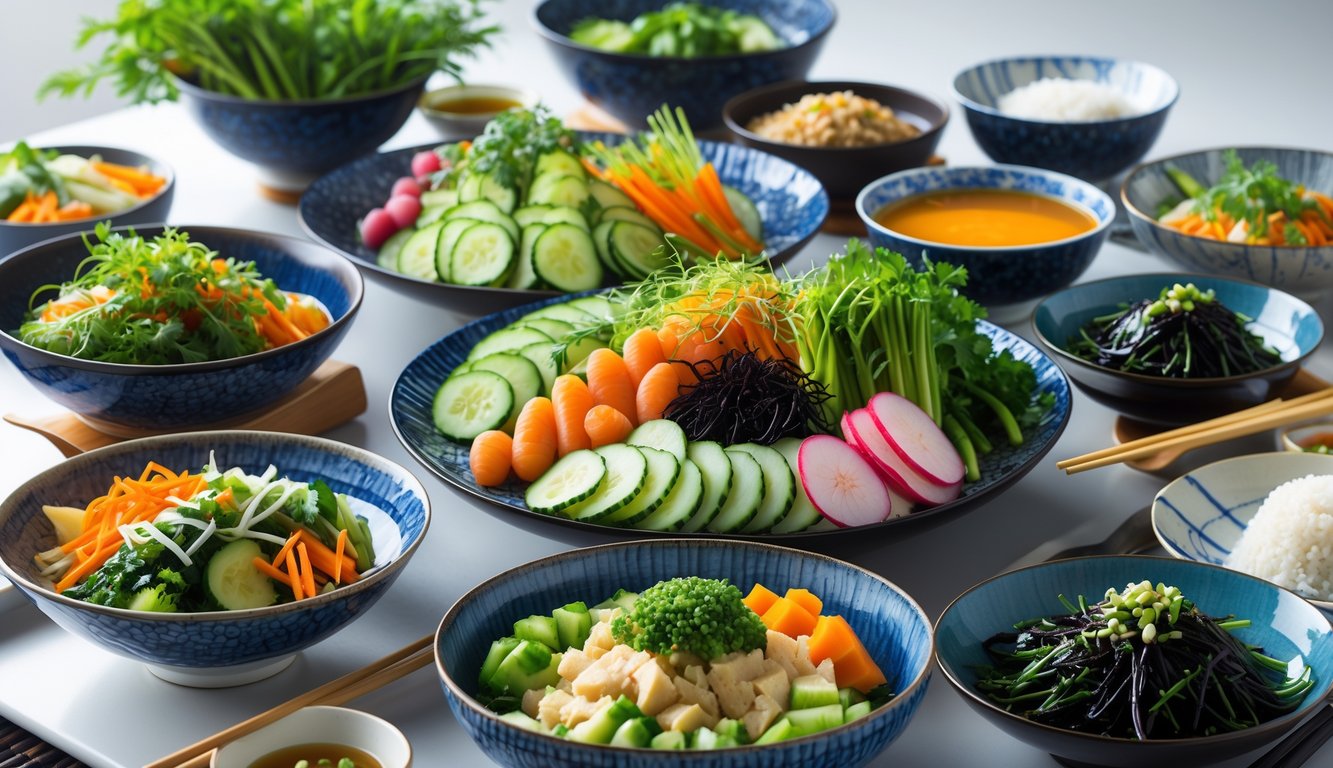
Popular Meat Dishes
Nobody warns you about how much meat sneaks into Japanese dinners until you count: yakitori, karaage, katsu, gyudon. Gyudon’s onions might be the real star, but the meat keeps you chewing. Maybe that’s why you notice you’re full before you overdo it. Once, in a Tokyo station, I inhaled tonkatsu so crisp it nearly shredded my mouth. Worth it. Fat-to-protein ratio is a thing, apparently. Diet analysts say moderation is the secret: smaller portions, more side dishes, never a steak the size of your head. Shabu shabu, gyoza, hambagu—they all sneak protein into dinner without making it a big deal. Why can’t I pull that off at home?
Tofu And Alternative Proteins
Tofu. Always there, pretending not to care, just lurking next to all those meats trying way too hard. Honestly, I never really craved tofu—what’s the deal? It’s got protein (like 8g per 100g, I think—I always forget the exact number), iron, and somehow never leaves me in a food coma. My neighbor in Osaka? She’s obsessed. Swears eating tofu cold in summer and hot in winter is some ancient secret for “tricking your stomach.” I just nod. No idea if it works, but she’s so serious about it I don’t have the heart to argue.
Seitan? Eh, it’s there, but natto—good grief, natto. It’s like eating glue if glue had a weirdly sour, intense personality. Edamame is the only one that feels normal—quick, salty, protein-y, actually fun to eat. I keep hearing nutritionists in Japan bicker about tofu vs. fish for “clean” protein, but honestly, most people just mix it up: tofu in miso soup, yuba (bean curd skin) in hotpot, and some veggie protein hiding in the corner. Oh, and nobody ever complains if you drop tofu into the soup. That’s rare.
Vegetables And Plant-Based Variety

Every meal, without fail, someone shoves pickled daikon or bamboo shoots at me. I don’t even know what half this stuff is, but Japanese food doesn’t let you dodge vegetables. Mushrooms, pickles, random bits of seaweed—suddenly I’m eating tofu again and forgetting it’s technically a plant.
Use Of Diverse Vegetables
Why is it that every time I eat at someone’s house in Japan, half my plate is mystery vegetables? Eggplant, burdock root (gobo), lotus root, kabocha—some of it sliced like it’s auditioning for a food magazine. There’s a study (2022, I think?) saying Japanese adults eat 250g+ of veggies daily. Learned that from a Keio nutritionist and immediately felt like a fraud.
And they don’t just steam stuff and call it a day. Raw, grilled, tempura, sautéed in miso, topped with random leaves. Tried making their mushrooms at home—total fail. The mushrooms in Japan taste like they’re from another planet. Bamboo shoots? In Japan, they’re tender and buttery if cooked right. At my store? Chewy pencils. No idea what I’m doing wrong.
Pickled And Fermented Foods
Pickled plums (umeboshi), those little cucumbers, ginger in weird colors—it’s all part of the deal. A Kyoto chef once told me, “Fermentation is real flavor.” He pointed at a jar of vegetables floating in sweet brine and miso. These bits show up everywhere, half-garnish, half palate reset.
It’s not about big flavors. It’s about those tiny sour things making every meal feel lighter. Even ramen at midnight comes with a pile of pickled cabbage or radish on top, like, why not? I wish my fridge at home had that kind of variety—pickled vegetables in Japan are just normal, not a “special” thing.
Iconic Plant-Based Dishes
Shojin ryori—Buddhist temple food—still blows my mind. No meat, fish, not even onions. Had it once in Nara: monk-chef gave me a tray with stewed pumpkin, sesame tofu, and a ton of mountain roots. No dairy, no eggs, but weirdly filling. A Tokyo dietitian told me, “Shojin meals average 500 calories, but people feel full.” Didn’t believe it until I tried.
And then there’s agedashi tofu, kinpira gobo, hijiki salad—never heavy, never loaded with sauce. You see them at izakayas all the time. Somehow, plant-based isn’t “trendy” in Japan; it’s just… standard. Plant-based foods aren’t new, they’re just there. Tofu is honestly the least weird thing on the table, which is saying something.
Umami-Rich Broths And Soups
There’s this aftertaste—briny, kind of cozy, kind of weird—that just sticks around. Dashi isn’t even the strangest thing I’ve had in Japan. It’s subtle, almost annoyingly so, but every spoonful just works, especially when you’re tired. Soup feels like cheating—small bowl, big effect.
Dashi: The Flavor Foundation
Step outside in Tokyo at midnight, and you’ll smell it—kombu simmering with dried bonito. Dashi. Looks boring: clear, almost nothing. But chemically, it’s wild. My chef friend loves to say, “Glutamate and inosinate, that’s it.” Science nerds in Japan obsess over this combo—read about it if you care. You think you want salt, but dashi hits a different spot.
Dashi runs the show in almost every soup or simmered dish. Even fake ramen flavors chase that dashi taste. Take it out and add more salt? Just dries out your tongue. Low-sodium miso soup still works because umami makes you salivate. Some people toss in dried shiitake for fun. Outside Japan, nobody cares this much about seaweed or bonito flakes, but here, it’s like bread—just basic.
Miso And Miso Soup
I used to think miso was just for hipster salad dressing, but in Japan it’s everywhere—like Velveeta, but, you know, edible. Fermented for years, smells funky, somehow comforting. Stir it into hot dashi and you get this salty, almost creamy soup—no dairy, just… fermentation. Nutritionists love it: fermented soy, enzymes, B vitamins, probiotics. Pills never did anything for me, but miso? Maybe.
Quality matters. Cheap packets are a scam—real miso gives you cloudy soup, tofu cubes, sometimes sad-looking wakame. Japanese health experts say miso soup helps cut salt but keeps you full. I cheat with powdered dashi and nobody notices. Maybe nostalgia helps, or maybe miso just works.
Hearty Noodle Soups
Ramen used to mean sad college noodles, until I went to Fukuoka. Tonkotsu ramen showed up: pork bones boiled forever, fat glistening, barely any toppings, all umami. Broth takes hours—some shops brag about it, there’s even a documentary (don’t watch it, it’s boring). Not all ramen is tonkotsu, though: shoyu, shio, whatever, usually start with dashi, sometimes chicken stock.
It’s not just ramen—udon, soba, every region has a soup, dashi or heavier broths, always tweaking the formula. Slurping? Totally normal—supposedly brings out the flavor, also keeps you from burning your mouth. Nutritionists claim noodle soups fill you up more than the calories suggest; dashi culture is half the secret. And, yeah, after a good bowl, my hair smells faintly fishy for hours. Worth it.



